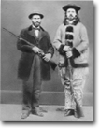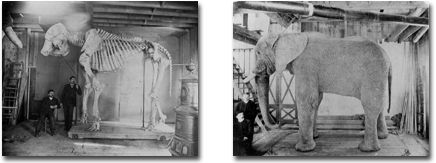Ward's Science History
Connecting Over 160 Years of Science Exploration, to Tomorrow's Science Innovation 
Henry Augustus Ward, 1834-1906 Not many institutions can boast of a founder who traveled around the world seven times, sat atop Mt. Sinai, and survived smallpox — all before the turn of the century! Ward’s Science is proud to preserve the spirit of its founder, Henry Augustus Ward, and carry on his spirit of science exploration, wonder, and innovation.
An Early Explorer From his first taste of travel at age 12, when he ran away from his Rochester, New York home, journeying to Chicago on foot and by lake steamer to visit his father, Henry’s quest for exploration and adventure never ceased. After attending school in the Rochester area, Ward attended Williams College for a year before studying at Harvard under the great naturalist Louis Agassiz. His education only added to an early passion for the natural sciences kindled at age 3, when Henry began his first geology specimen collection.
In 1854, at age 20, Ward was sent to Europe as tutor to his boyhood friend, Charles Wadsworth. The young men traveled together throughout Europe, then crossed the Mediterranean to Egypt, and descended the Nile. It was on their way across the desert to Jerusalem that Henry climbed Mt. Sinai, weathering an incredible storm there. Ward survived his desert trek through hostile territory by taking refuge with a friendly band of Bedouins. The collection of fossils and minerals Ward gathered during this eight-month excursion is housed in the Buffalo Museum of Science, in Buffalo, NY.
Henry stayed on in Europe, financing his geological studies at the Paris School of Mines by selling fossils. He forged relationships with professors and scientists from Russia to Portugal, where natural science research was enthusiastically supported. He even made an expedition to Africa before returning once again to Rochester. It was on the African coast, where Henry insisted on living the life of the natives while gathering materials for his ever-expanding collections, that he contracted smallpox. He was nursed for weeks by a native woman, who later proposed that Henry marry her. His diary does not detail his escape, but after his return to America, he sent a great packing crate filled with gifts to his African nurse. On the Cutting Edge of “Collection Fever” Shortly before the turn of the century, American colleges and universities began catching "collection fever," housing complete geological collections from around the world for students to expand their studies with hands-on specimens. Henry Ward was one of the first to notice this trend, and It was then that Ward’ Natural Science Establishment had its formal beginnings.
In 1862, Vassar Female College commissioned Ward to prepare a collection, one of the first he would sell, which he assembled on the University of Rochester campus. After a fire ravaged his campus building, Cosmos Hall, Ward established his private business away from the university grounds and began attracting notable individuals, talented European scientists, and men who would go on to greatness from their beginnings at Ward’s Natural Science Establishment.
 Legendary Preparations, Lifelong Friendships Among the famous characters that Ward transacted with was William F. Cody, better known as Buffalo Bill. Cody journeyed from the Wild West to Rochester to engage Ward’s Natural Science in preserving some buffalo heads from Cody’s hunting expeditions. The two adventurers quickly became lifelong friends.
Ward’s projects were always on a grand scale. In 1893, he mounted the largest single display at the Chicago World’s Fair. The Columbian Exposition, prepared for months in advance by 74 workmen, occupied a full 30 train cars. This exhibit of Ward’s collection won a blue ribbon and was purchased by retailer Marshall Field, who presented it to the city as the basis of the Chicago Museum of Natural History, the Field Museum. 
Also on a "grand scale" was Ward’s work for legendary circus leader, P.T. Barnum. Jumbo, Barnum’s famed circus elephant, was the largest in captivity and beloved by Barnum and all who traveled to see his show. After Jumbo met an untimely fate and was struck head-on by a locomotive, Barnum commissioned Ward’s Natural Science to mount Jumbo’s skin and skeleton so he could continue traveling with the show. Ward and renowned taxidermist Carl Akeley, future director of the American Museum of Natural History, worked almost two years to preserve the 12-foot-high, 14-foot-long, 6 ½ -ton elephant, and the beloved Jumbo’s traveling circus career continued well beyond his unfortunate demise.
Ward’s final collecting passion, which transcended any scientific interest he had held before, was meteorites. His obsession took him to Europe, to Persia, to Mexico, even on a wearying voyage to Colombia at age 71.
His plan for a trip across the southern Andes in search of more meteorite specimens was tragically thwarted. On July 4, 1906, Henry Ward was fatally injured by an automobile while walking on the street in Buffalo, New York; his was the first automotive fatality in the city.
Yet even in death, Ward continued to serve science educators and students. At the request of his friend, Dr. Bert Wilder, Henry Ward’s brain was donated to Cornell University for research on the “physical characteristics of a brilliant mind.” Wilder was studying a selection of brains from brilliant men like Ward, criminals, and politicians. Ward’s ashes now rest in Mount Hope Cemetery in Rochester, NY. Continuing the Spirit of Science Exploration for Tomorrow’s Generation Today, Ward’s Science strives to carry on in the spirit of our founder, Henry Augustus Ward, with his infinite sense of wonder and dedication to bringing the natural sciences, innovative technology, complete curriculum activities, and time-saving resources into science classrooms, so teachers can inspire their students to embark on their own journey of science discovery.
Follow our journey of science innovation over 150 years. Click here to view the full timeline. |